By Chandrasekhar Ramanujan
After having joined as a Product Designer at Gojek, a few months ago, I went on a quest to improve my writing and documentation skills. I got an opportunity to volunteer with our amazing Design Ops team on an interesting project around how language affects our Design team.
I thought it would be a simple, straightforward project, but boy was I wrong! It was very different from the kind of product design I am used to and I was all set to be pushed out of my comfort zone. Taking up this new project meant that instead of designing digital apps and services, I’d be designing internal team processes. And it turned out to be one of the most complex projects I’ve worked on.
What is Gender Coding?
Companies are coming to realise the benefits of making the workplace more diverse — from greater creativity and innovation, to being able to better empathise with a wider range of users. In order to improve the diversity of their talent pool, companies have started to try many initiatives. But there is one seemingly simple thing that has a great negative impact if done wrong: The language used to describe job openings.
You’re probably thinking: “Language? How can that impact diversity?”
Let’s zoom out a little.
Consider the following words:
Nurse.
Firefighter.
Singer.
What image came into your mind when you read those words? What did they look like? What kinds of associations did they create in your mind?
Unlike many other languages, English has very few words with a clear gender. However, we can still react to words differently based on our experience, beliefs, and stereotypes. Our language can also change depending on which gender we refer to, with some words used more often to describe men than women, and vice versa. Over time, these words become linked to a specific gender. This is gender coding.
Research studies show that women aren’t as likely to apply for jobs that are advertised with masculine-coded language and vice versa (to a smaller extent).
Take a look at this job ad posted below:
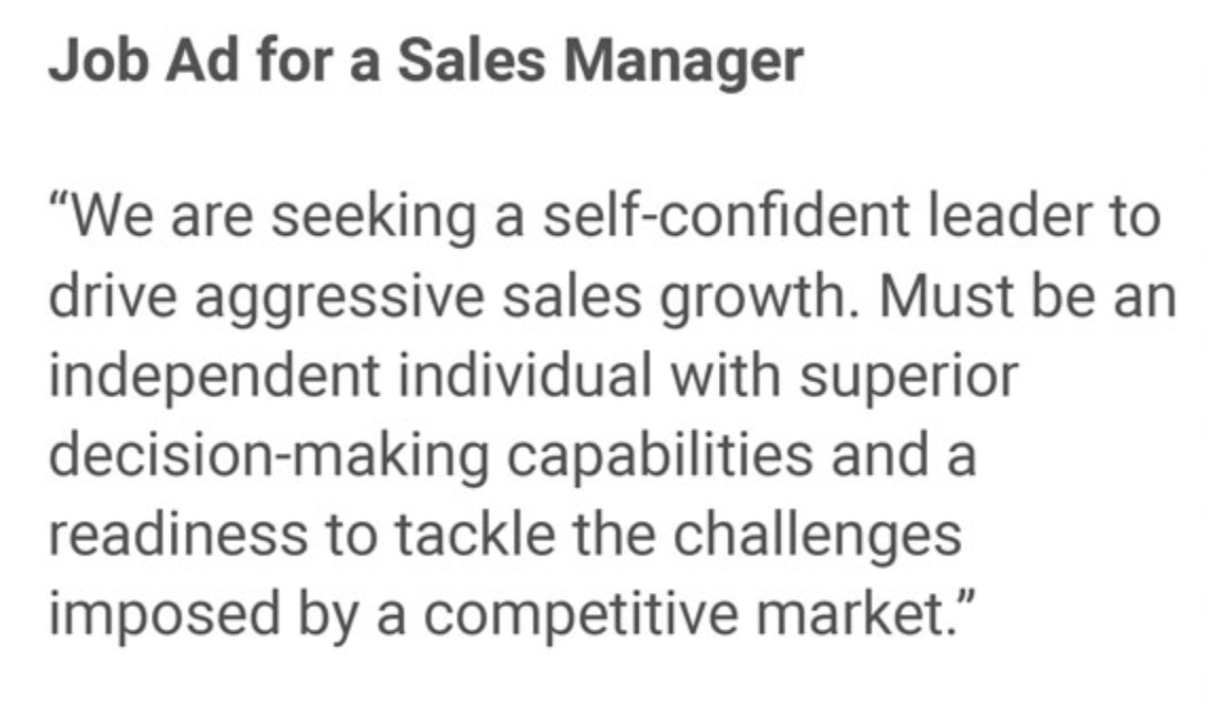
It’s full of words associated with male stereotypes like competitive, dominant, leader, challenge. And zero words that are associated with female stereotypes like support, understand, interpersonal, co-operate, connect.
When candidates apply, they end up asking themselves — Am I who they are looking for? Would I fit in? Do I belong in this job? It’s reasonable to assume that male candidates would be more drawn to this job ad than female candidates.
How gender coding affects job applicant behaviour
It’s important to understand that this is not an explicit/obvious phenomenon — it’s subtle, where the word association happens at a subconscious level due to internalised stereotypes. It’s also not deliberately done by the writer of the job description. Usually they think of the qualities they themselves have, and write a job description to attract more people like themselves.
This ends up being a vicious circle. Gendered words in job advertisements make a position seem less appealing to a certain gender, and limit the applicant pool for these jobs.
For example, a strongly masculine coded job ad will have more men than women apply, and that the job will end up being filled by another man, and when it’s his turn to write another job description, he will most likely write another strongly masculine-coded ad and once again, more men will apply.
So why is this a problem? If a company wants to attract more women applicants, for example, then if the gender coding in their job advertisements could be discouraging them from applying in the first place, then that is a serious concern that needs to be addressed since it is preventing the company from being a diverse workplace.
I took a look at the numbers for our design opening applications in 2022, and I came across an interesting insight. While most of our job ads are not masculine coded, the more senior the role the more likely it is masculine coded, and that trend is reflected in the applications we receive — where junior roles and a higher ratio of women applicants than senior roles. Basically that means the ratio of women to men applicants went down as the seniority of the job post went up.
This was a good starting point. But I needed more data.
Digging deeper
On top of this initial analysis, I did initial qualitative interviews with 4 women designers, 2 in Gojek and 2 outside Gojek. I tried to understand what all were the data points that they paid attention to when applying, and any anecdotes of red flags they encountered.
I also came across a tweet thread from a woman designer who was applying for the job search and had talked about her experiences
Based on this, I got the following insights. The designers would look at the company page and LinkedIn to see who all were the designers there, and how they had been featured. For example does the team page only have photos of men? That could be a red flag.
They would also talk to other designers at the company to learn more about what the work environment and atmosphere would be like.
Finally they would accord maximum weight to the first conversation they had with the company, such as with a recruiter/HR, as well as if they came across any red flag in panelist interactions during the interview process.
Creating the problem statement
I also analysed all the Gojek job ads that were live as of 27th May, using the “Gender Decoder” tool, and tried to visualise it by specialisation (Interaction Design or Motion design versus Product Design, which is more generalist) and seniority (IC vs manager, years of experience, etc.)
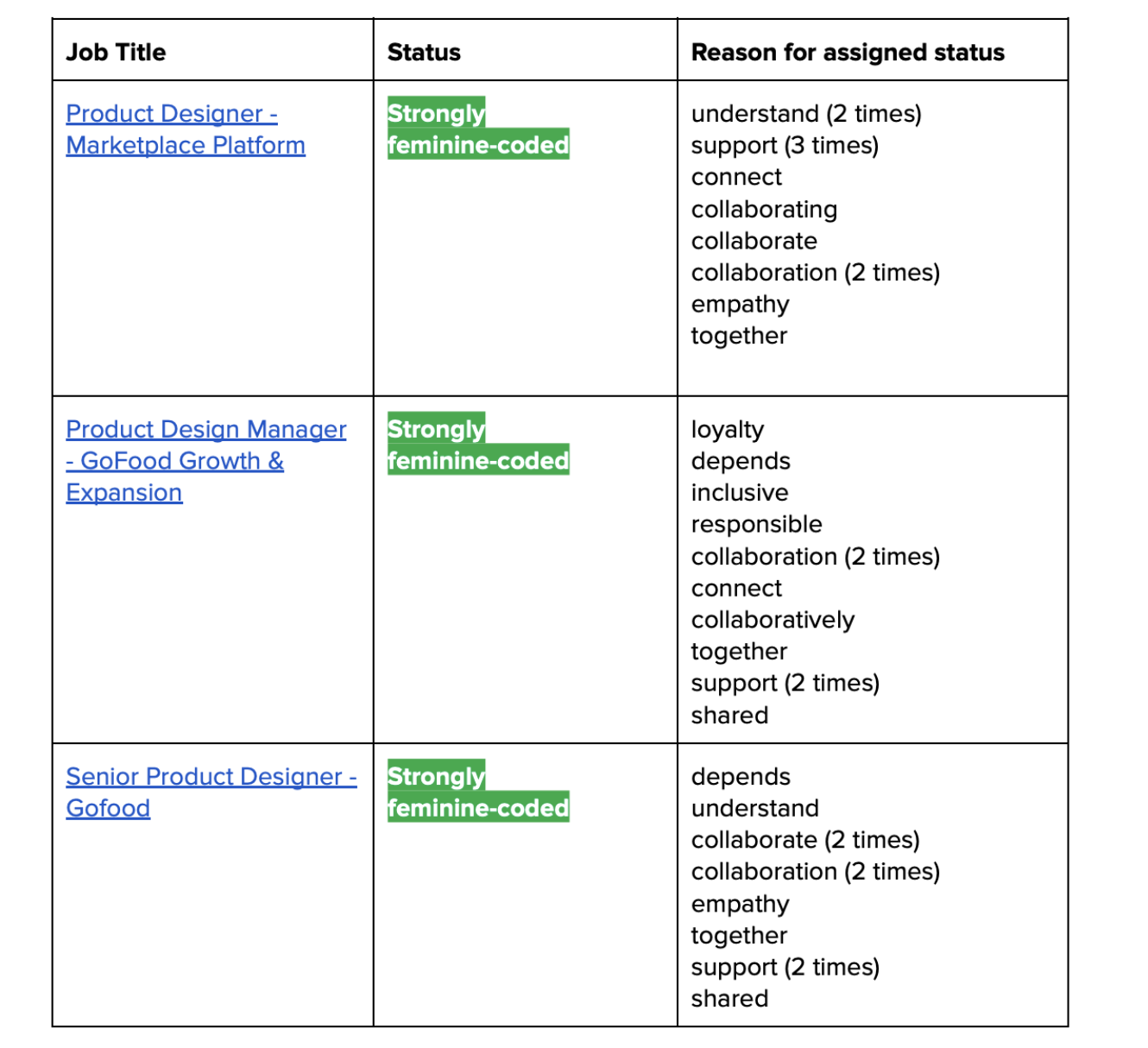
The insights I got was that the JD coding followed the axis of seniority and specialisation — the more senior a role, the more likely it was for the job ad to contain masculine coded words. At the same time, the more specialised the role, the less likely it was to contain feminine coded words.

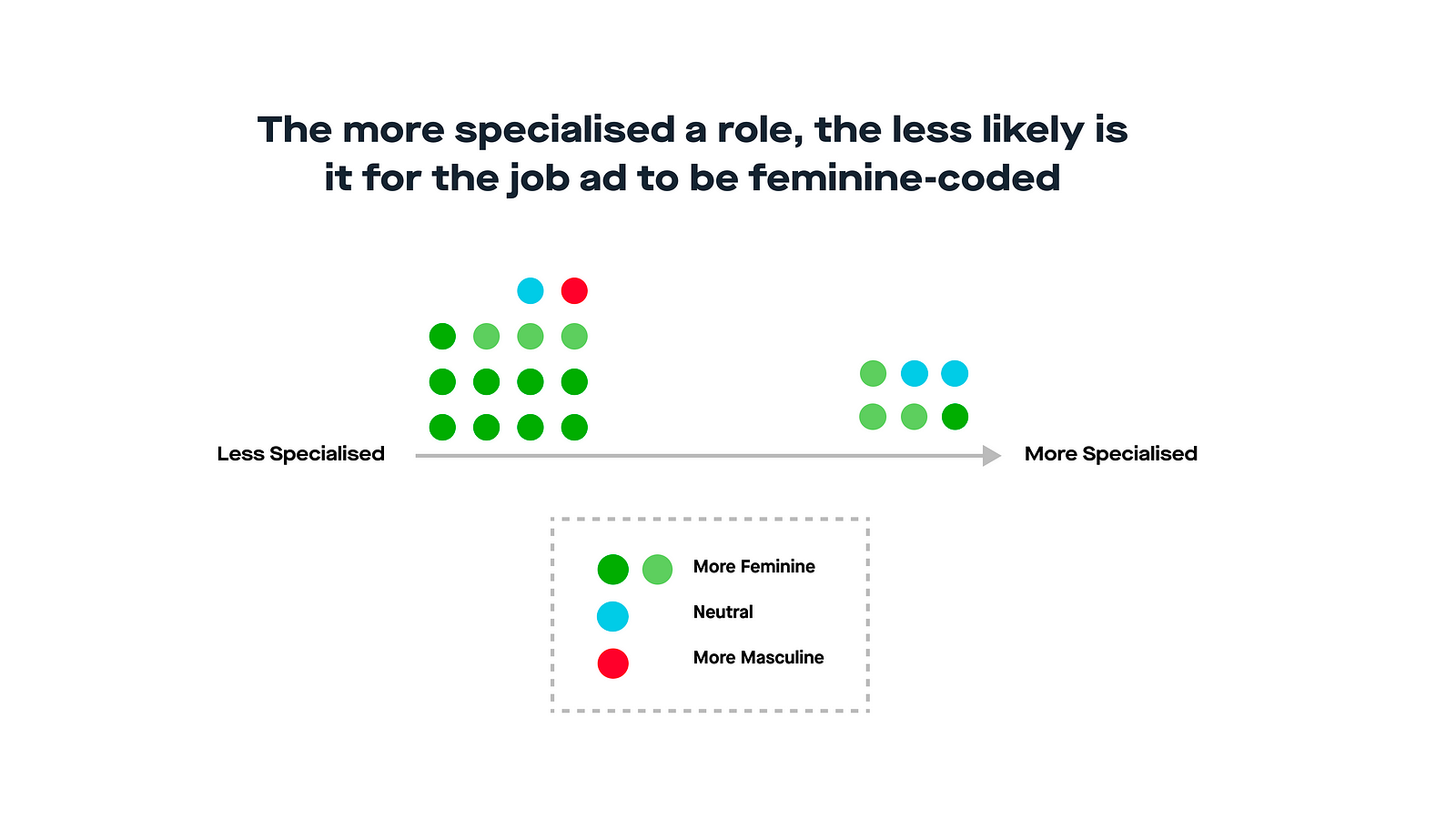
Based on that, I defined the objective now as to make the Gojek job ads and internal career ladder documents to be as gender neutral as possible.
I looked into the best practices, and developed a checklist for people to refer to as they are writing the documents, as well as a list of words to avoid using too much.
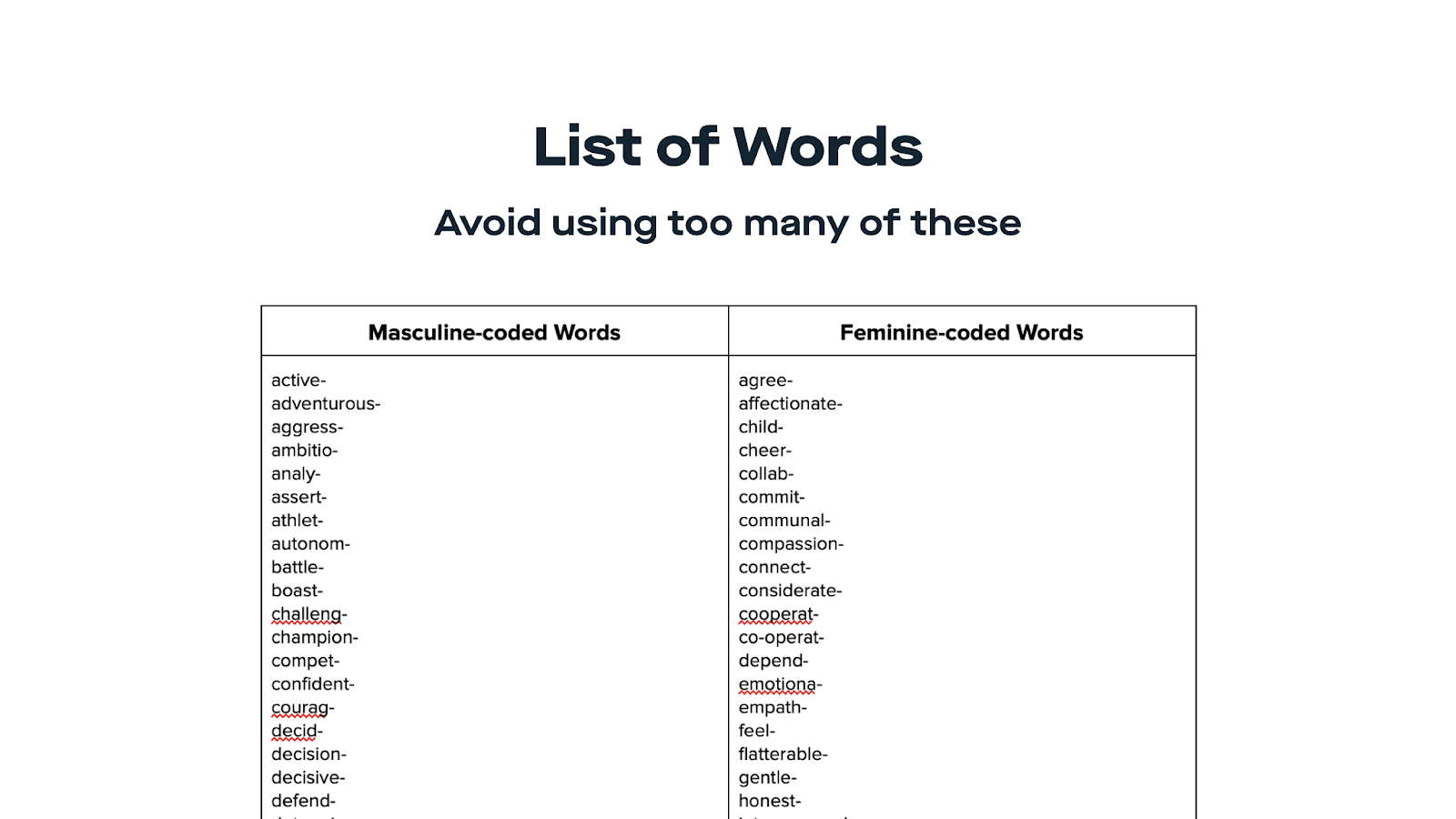
One big ask was for help in order to find alternatives to gender coded words.
I came across an insight that most of the gender coded words are adjectives or qualities, and to bypass that, the writer should use descriptive words where necessary to indicate what candidate does vs. who they should be. For example, do not use adjectives like superior, exceptional, or first rate without additional evidence to back them up as to what you mean. If adjectives are needed, use it to describe the candidate’s actions or skills instead of the candidate themselves.
Here is an example below:
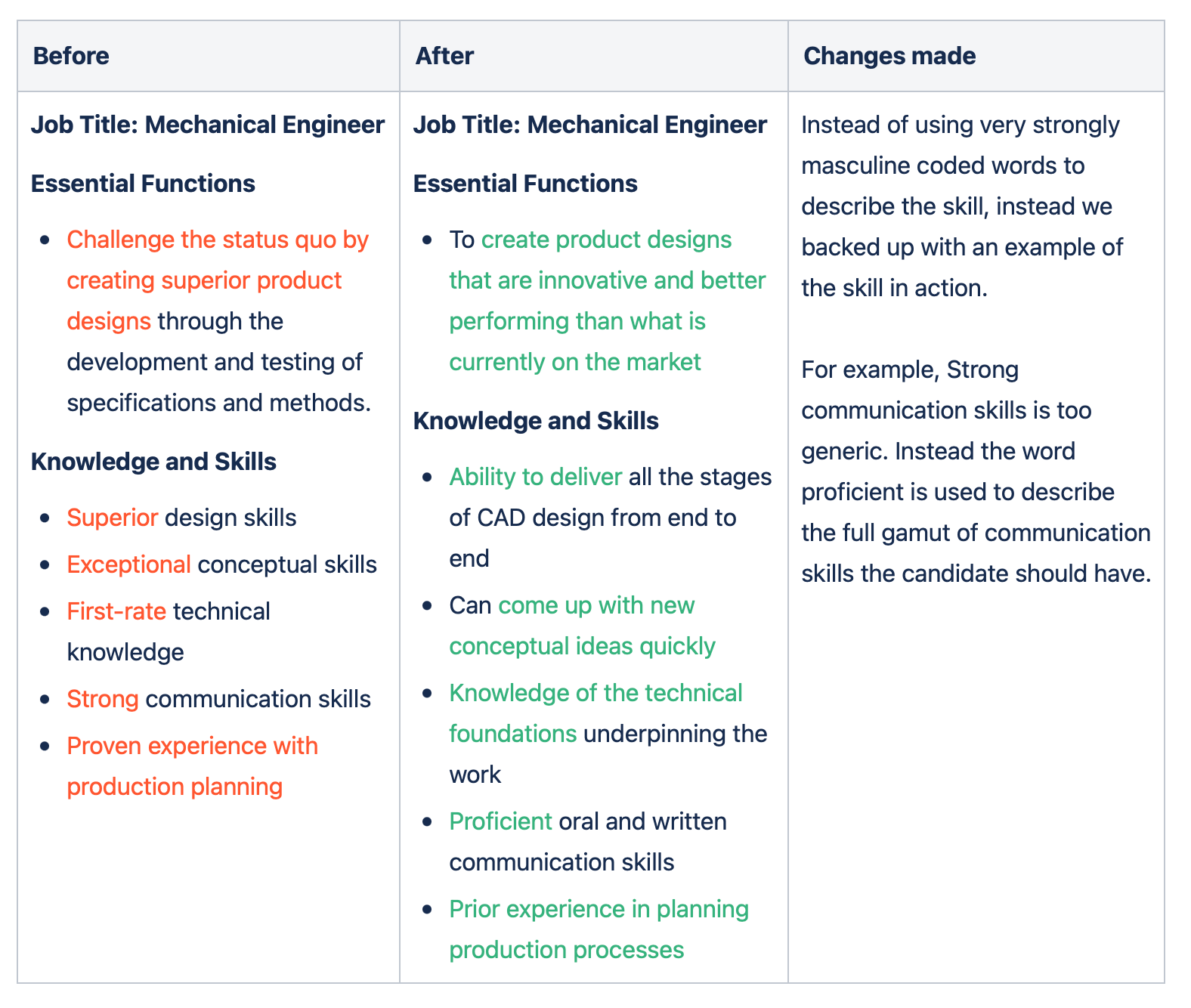
I also came up with a few more steps as an SOP:
1. Pass all ads through a gendered language test such as the “Gender Decoder” by Kat Matfield
2. Consider the use of words in senior job ads in particular
3. Avoid ‘cut and paste’ job ads where the previous job ads are used as the basis to write new ones, thus perpetuating the existing issues
4. List only the skills that are absolutely necessary for the role
What happens next?
Now for next steps. Of course, we can’t say that the language of the job ad is the only reason for the lopsided ratio of diversity in organisations. There are a range of factors that influence gender ratio, and the job ads language is one that’s under our control, and an easy one to fix.
We are also looking at where we advertise jobs (could some job boards more male-focused than others, for instance? And I also recommended a ‘Blind’ panel process to strip out name/gender details to remove any subconscious bias on part of the recruiters.
As a designer, I also learned a lot about a lot of team-building and HR related topics, and how to apply a designer’s lens to problem areas that we would not traditionally be associated with. This was not a problem I could solve by jumping onto a tool and making a prototype. I had to understand a lot about team dynamics and existing processes which are more implicit and intangible, and figure out how to work within those.

Find more stories from our vault, here.
Check out open job positions by clicking below:


